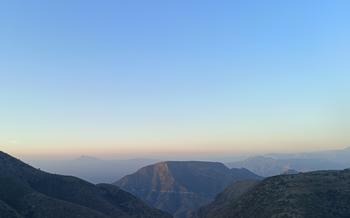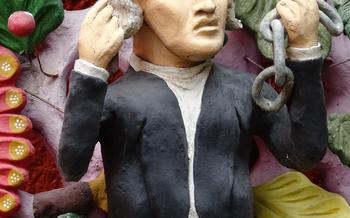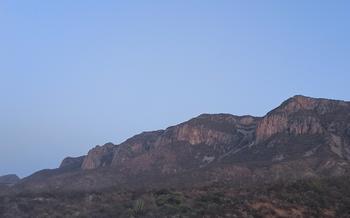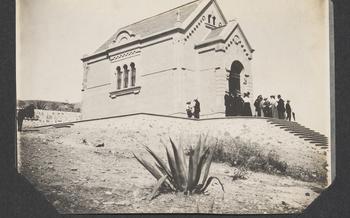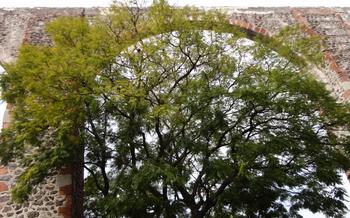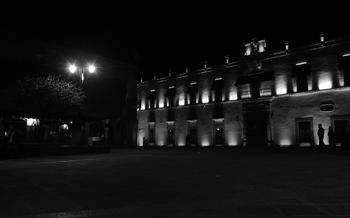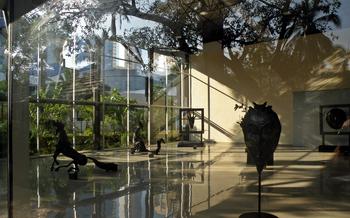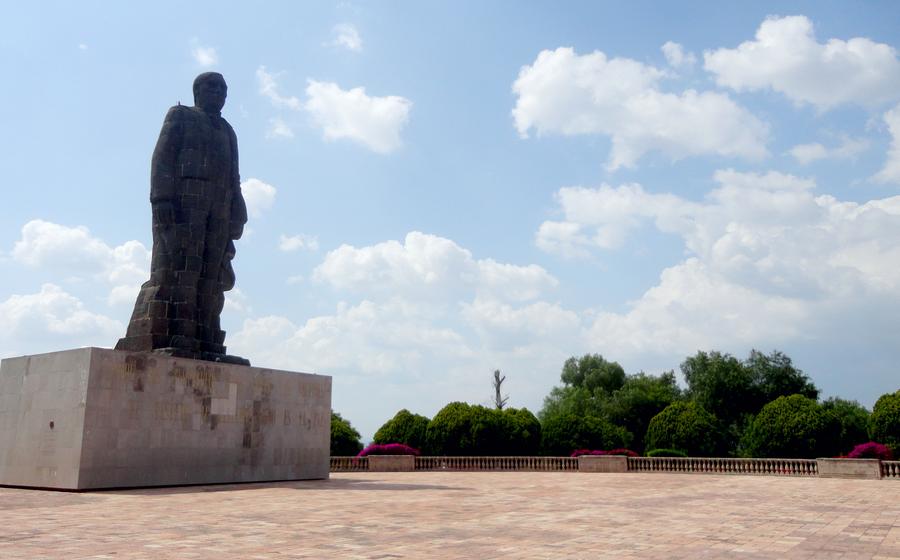
Cerro de las Campanas National Park
- History of Cerro de las Campanas National Park
- Archaeological Significance:
- Military Battles:
- Mining Activities:
- Unique Geological Features
- Historical Monuments
- Cerro de las Campanas Trail
- Flora and Fauna
- Picnic Areas and Camping Facilities
- Guided Tours and Educational Programs
- Tips for Planning Your Visit
- Other Activities to Enjoy
- Cerro de las Campanas Museum
- The Legend of El Cerrito
- Accessibility and Transportation
- Safety Precautions
- Local Cuisine and Restaurants
- Insider Tip: Uncovering Hidden Gems
History of Cerro de las Campanas National Park
Cerro de las Campanas National Park holds immense historical significance in Queretaro. Its rich past encompasses a blend of archaeological discoveries, military battles, and mining activities.
Archaeological Significance:
The park is home to various archaeological sites, including the remnants of an ancient Otomi settlement. Excavations have revealed artifacts and structures that provide valuable insights into the region's pre-Hispanic history and the lives of its indigenous inhabitants.
Military Battles:
Cerro de las Campanas played a crucial role during the Mexican-American War. In 1847, Mexican forces and American troops engaged in a fierce battle on the hill, resulting in a Mexican victory. The park's strategic location made it a pivotal battlefield, and its historical significance continues to be commemorated.
Mining Activities:
The park's hills were once dotted with silver mines, leaving behind a legacy of mining activity. While the mines are no longer operational, they serve as a reminder of the region's mining past and its contributions to the local economy and history.
Unique Geological Features
Cerro de las Campanas National Park is renowned for its exceptional geological formations. The park's most distinctive feature is El Cerrito, a hill composed of unique rock formations that resemble giant bells, hence the name "Cerro de las Campanas" or "Hill of the Bells." These rock formations were shaped by millions of years of erosion, resulting in intriguing shapes and textures that captivate visitors.
In addition to El Cerrito, the park is home to a network of caves and tunnels that offer a glimpse into the region's subterranean world. These caves were formed by the dissolution of limestone rock by acidic groundwater, creating intricate passageways and chambers. Visitors can explore some of these caves, such as the Cueva del Diablo and the Cueva de las Lechuzas, with the guidance of experienced guides.
The park's elevated location also provides breathtaking panoramic views of the surrounding landscape. From the top of El Cerrito, visitors can enjoy stunning vistas of the city of Querétaro, the Sierra Gorda mountain range, and the vast Bajío region. These panoramic views make Cerro de las Campanas a popular spot for photography enthusiasts and nature lovers alike.
Historical Monuments
Cerro de las Campanas National Park is home to several historical monuments that add to its cultural significance. One of the most notable landmarks is the Aqueduct of Santiago de Querétaro. Built in the 18th century, this impressive aqueduct was designed to transport water from the nearby springs to the city of Querétaro. Its majestic arches and intricate stonework make it a true architectural marvel.
Another must-visit site is La Cruz viewpoint. Perched atop the hill, this viewpoint offers breathtaking panoramic views of the surrounding landscape. Here, you can admire the city of Querétaro nestled amidst the rolling hills, and on clear days, you can even catch a glimpse of the distant Sierra Gorda mountains. The viewpoint is also home to Temple of La Cruz, a small chapel built in the 18th century that adds to the site's historical and spiritual significance.
Cerro de las Campanas Trail
The Cerro de las Campanas National Park offers a range of hiking trails tailored to different fitness levels, allowing visitors to explore the park's diverse landscapes. The trails are well-marked and maintained, ensuring a safe and enjoyable hiking experience.
For those seeking a leisurely stroll, the Sendero El Mirador is an ideal choice. This short trail leads to the La Cruz viewpoint, offering panoramic views of the city and the surrounding mountains. It is easily accessible and suitable for all fitness levels, making it perfect for families with young children or visitors with limited mobility.
More experienced hikers can tackle the Sendero Las Grutas, which takes you through a series of caves and tunnels. This challenging trail offers a unique perspective of the park's geological formations and requires a moderate level of fitness and proper gear.
Hikers of all levels will appreciate the Sendero La Cruz, which leads to the Temple of La Cruz, a historic monument perched atop the hill. This trail offers a moderate challenge and stunning views along the way.
Remember to follow the park's trail markers and safety guidelines, stay hydrated, and wear appropriate footwear and clothing for your chosen trail.
Flora and Fauna
Endemic plant species
The Cerro de las Campanas National Park is home to a diverse array of plant life, including over 300 species of vascular plants. These include several endemic species, such as the Queretaro agave (Agave queretaroensis) and the Cerro de las Campanas milkweed (Asclepias cerrolascampanensis). These endemic species are found nowhere else in the world and play a vital role in the park's ecosystem.
Wildlife sightings
The park is also home to a variety of wildlife, including birds, reptiles, and mammals. Visitors can spot a variety of birds, such as the golden eagle, the peregrine falcon, and the cactus wren. Reptiles include the Texas horned lizard, the black-tailed rattlesnake, and the northern alligator lizard. Mammals include the coyote, the bobcat, the white-tailed deer, and the nine-banded armadillo.
Conservation efforts
The park is committed to protecting its unique flora and fauna. Several conservation efforts are in place, including habitat restoration projects, reforestation efforts, and the establishment of a wildlife sanctuary. These efforts help to ensure that the park's biodiversity is preserved for future generations.
Picnic Areas and Camping Facilities
Cerro de las Campanas National Park offers several designated picnic spots, providing a scenic and tranquil setting for visitors to enjoy their meals outdoors. These areas are equipped with picnic tables, grills, and trash cans, making them ideal for families and groups to gather and have a picnic amidst the natural beauty of the park.
For those seeking a more immersive experience, the park also features campgrounds with basic amenities such as restrooms, showers, and tent pads. Campers can choose from various campsites, ranging from primitive backcountry sites to more developed areas with hookups for RVs. Camping permits are required and can be obtained at the park's visitor center.
Whether you prefer a leisurely picnic or an overnight camping adventure, Cerro de las Campanas National Park provides ample opportunities for visitors to connect with nature and create lasting memories.
Guided Tours and Educational Programs
Cerro de las Campanas National Park offers guided tours for visitors interested in delving deeper into its historical, cultural, and natural significance. Knowledgeable guides lead these tours, sharing captivating stories and insights about the park's landmarks, battles, mining activities, and geological formations.
Educational workshops and activities are also organized to enhance visitors' understanding and appreciation of the park's diverse ecosystems, unique flora and fauna, and cultural heritage. These programs are designed for all ages and provide hands-on experiences, interactive displays, and engaging presentations.
By participating in guided tours and educational programs, visitors can gain a deeper appreciation for the park's natural beauty, rich history, and ongoing conservation efforts. These programs offer a unique opportunity to learn from experts and create lasting memories while exploring the wonders of Cerro de las Campanas National Park.
Tips for Planning Your Visit
For the best experience at Cerro de las Campanas National Park, careful planning is key. Consider visiting during the cooler months (October to April) to avoid the intense summer heat. Research any special events or festivals that might align with your visit, such as the annual Querétaro International Film Festival or the Festival de las Culturas Populares Indígenas.
Packing essentials include comfortable hiking shoes, layers of clothing for changing weather conditions, a hat, sunscreen, and plenty of water. The park offers designated picnic spots, but you can also bring your own picnic basket filled with snacks and drinks.
When it comes to accessibility, the park is wheelchair-accessible through designated trails and ramps. Parking is available at the park entrance, with fees varying depending on the length of your stay. To ensure a smooth visit, check the park's website or contact the visitor center for the most up-to-date information on accessibility, parking, and any special events.
Other Activities to Enjoy
In addition to the peaceful hiking trails, Cerro de las Campanas offers a range of exciting activities that cater to adventurous souls. Rock climbing and rappelling enthusiasts will find ample opportunities to scale the rugged cliffs, while mountain biking trails wind through the park's undulating terrain, providing an exhilarating ride amidst breathtaking scenery.
For those seeking a more cultural experience, the park hosts a variety of events and festivals throughout the year. These events showcase the rich cultural heritage of Queretaro, featuring traditional music, dance performances, art exhibitions, and local culinary delights. Whether you're an avid climber, a passionate biker, or simply seeking a vibrant cultural immersion, Cerro de las Campanas has something to offer everyone.
Cerro de las Campanas Museum
Enrich your visit to Cerro de las Campanas with a stop at the on-site museum, a treasure trove of knowledge about the park's intriguing history and geological wonders. Immerse yourself in interactive displays that bring the park's past to life, showcasing the stories of ancient civilizations, military conflicts, and mining activities that have shaped the landscape. Learn about the park's unique geological formations, including the iconic rock formations and hidden caves, through engaging exhibits. Guided tours and educational workshops are available to deepen your understanding and provide a comprehensive overview of the park's rich heritage.
The Legend of El Cerrito
The Cerro de las Campanas is steeped in local folklore and mythology. According to legend, the hill was once home to a group of indigenous people who lived in harmony with nature. One day, a group of Spanish conquistadors arrived and attempted to take over the land. The indigenous people resisted, but they were outnumbered and outgunned. As the Spanish soldiers closed in, the indigenous people fled to the top of the hill and took refuge in a cave.
The Spanish soldiers surrounded the cave and set it on fire. The indigenous people inside were trapped and slowly suffocated to death. As they died, their spirits rose from the cave and transformed into bells. The bells then began to ring, filling the air with a mournful sound.
The ringing of the bells can still be heard today, especially on windy days. Local people believe that the bells are a reminder of the indigenous people who died on the hill and that they are a symbol of the strength and resilience of the Mexican people.
The legend of El Cerrito is a powerful reminder of the importance of protecting Mexico's cultural heritage. It is also a reminder that even in the face of adversity, the Mexican people have always found a way to survive and thrive.
Accessibility and Transportation
Cerro de las Campanas National Park is conveniently accessible by public transportation. The QroBus system offers several routes that stop near the park entrance, making it easy to get there from various points in the city.
For those driving, ample parking is available at the park entrance. The parking lot is well-maintained and offers designated spaces for cars, buses, and RVs. Parking fees are reasonable, and payment can be made in cash or with a credit card.
The park is wheelchair accessible, with designated trails and ramps. Visitors with disabilities can also take advantage of the accessible restrooms and picnic areas. Additionally, the park offers guided tours specifically designed for individuals with disabilities, ensuring an inclusive and enjoyable experience for all.
Safety Precautions
When exploring Cerro de las Campanas National Park, it's crucial to prioritize safety. Be aware of common safety concerns such as uneven terrain, wildlife encounters, and potential weather changes. Stay on designated trails to avoid getting lost and respect wildlife by observing them from a distance. If you encounter any dangerous animals, remain calm and back away slowly.
Wildlife Encounters and Precautions:
The park is home to a variety of wildlife, including snakes, coyotes, and insects. While most animals are not aggressive, it's essential to take precautions. Avoid touching or feeding wildlife, and keep your distance to prevent any encounters. Be cautious when hiking in tall grass or dense vegetation, as snakes may be present.
Emergency Contact Information:
In case of an emergency, be prepared with the necessary contact information. Keep your phone fully charged and store emergency numbers, such as the park ranger station and local authorities, in your contact list. If you experience any medical issues or accidents, seek assistance immediately.
Local Cuisine and Restaurants
Queretaro's culinary scene is a vibrant tapestry of flavors that reflects the region's rich cultural heritage.
-
Traditional dishes like enchiladas queretanas, gorditas de migajas, and pollo en salsa verde are must-try delicacies.
-
For a unique dining experience, head to one of the many rooftop restaurants in the city center, offering panoramic views of the Cerro de las Campanas and the surrounding landscapes.
-
If you prefer a casual picnic, pack a basket with fresh local produce, homemade snacks, and a bottle of Queretaro's famous sparkling wine. Designated picnic spots within the park provide the perfect setting to savor your meal while enjoying the tranquility of nature.
Insider Tip: Uncovering Hidden Gems
For an unforgettable experience, discover the lesser-known trails that lead you to secluded viewpoints offering breathtaking panoramas of the city and the surrounding landscapes. These hidden gems provide a tranquil escape from the crowds, allowing you to immerse yourself in the park's serene beauty.
Plan your visit to coincide with the magical sunsets that paint the sky with vibrant hues, transforming the park into a picturesque canvas. Capture the essence of this special moment as the sun dips below the horizon, casting a warm glow over the park's landmarks and creating a truly enchanting atmosphere.
To fully embrace the local culture, time your visit to coincide with vibrant festivals or events held in the park. These celebrations offer a unique opportunity to witness traditional performances, indulge in regional delicacies, and connect with the warm and welcoming community of Queretaro.
